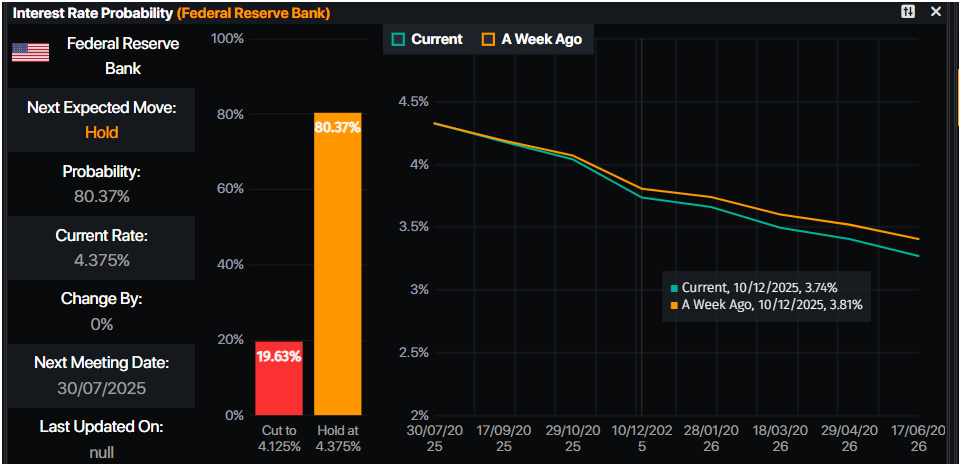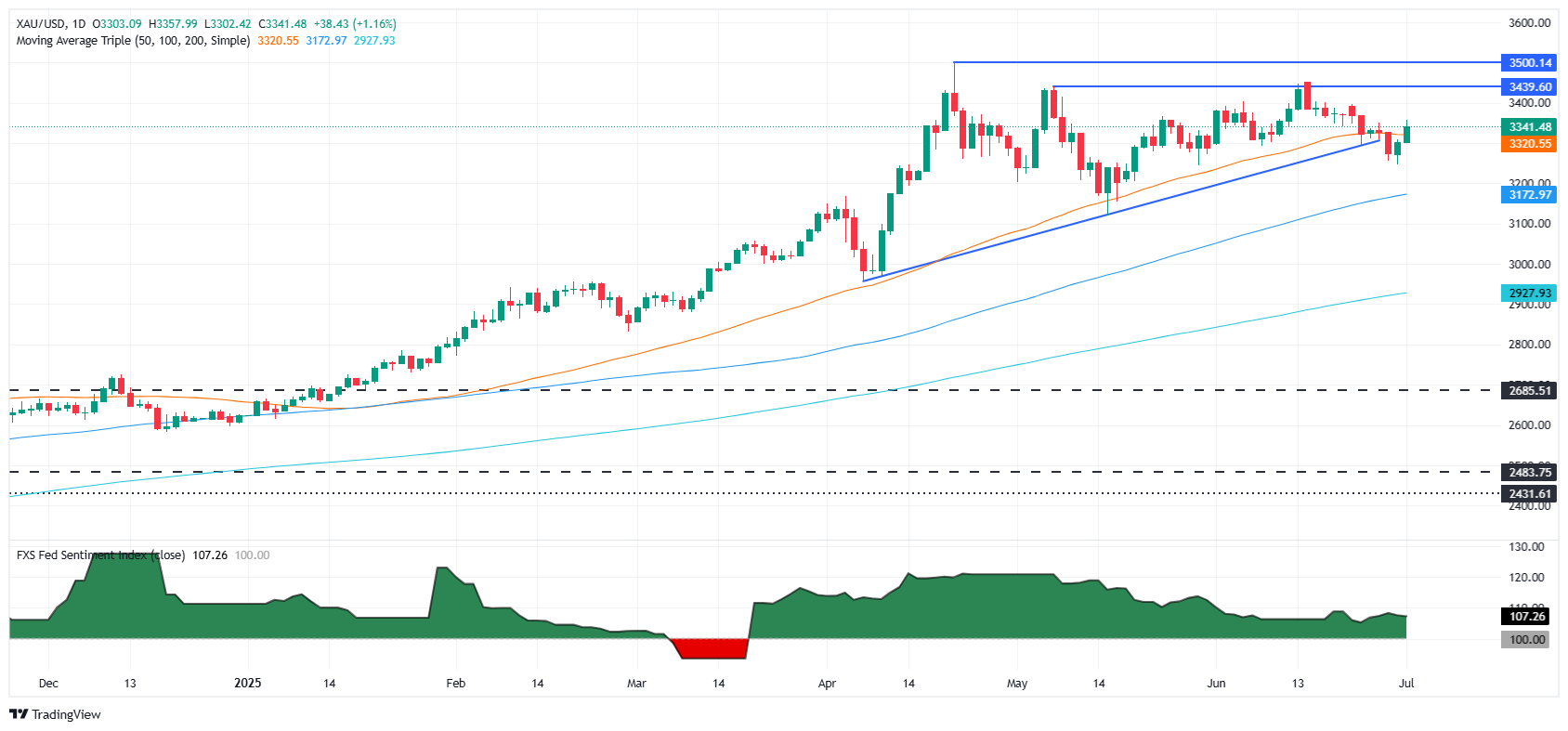- Gold rallies to four-day high as DXY recovers after touching fresh three-year low.
- US Senate passes $4.5T tax cut bill; Bullion market largely unmoved by fiscal headlines.
- JOLTS Job Openings and ISM data support Powell’s wait-and-see stance; ADP and NFP in focus next.
The Gold price rises over 1% as the Greenback pares some of its earlier losses, which sent the US Dollar Index (DXY) to a three-year low. Meanwhile, the US Senate passed the Trump tax bill, which is ready to be sent to the House of Representatives for its approval. At the time of writing, XAU/USD trades at $3,340, trading around four-day highs.
Bloomberg revealed that “Senators voted 51-50 to pass the bill. Vice President JD Vance cast the tie-breaking vote. The package, which now goes to the House, combines $4.5 trillion in tax cuts with $1.2 trillion in spending cuts.”
The passage of the bill was ignored by Bullion traders so far. Economic data from the United States (US) was not ignored, justifying Federal Reserve (Fed) Chair Jerome Powell’s wait-and-see stance.
The US Job Openings and Labor Turnover Survey (JOLTS) revealed that vacancies increased in May, exceeding economists’ forecasts. Manufacturing activity, as reported by the Institute for Supply Management (ISM), contracted for the fourth consecutive month but showed signs of improvement, approaching the expansion/contraction threshold.
Recently, Powell crossed the wires and remained slightly hawkish.
Aside from this, US Treasury Secretary Scott Bessent warned that countries could be notified of higher tariffs as the July 9 deadline approaches.
This shortened week, ahead of the US Independence Day on July 4, will feature ADP employment figures, Initial Jobless Claims, and the Nonfarm Payrolls report for June.
Daily digest market movers: Gold price climbs as US yields and US Dollar advanced
- Gold continues to rally, even as US Treasury yields rise. The 10-year US Treasury note is yielding 4.242%, a three-and-a-half basis point increase. US real yields, which are calculated by subtracting inflation expectations from the nominal yield, are also moving up close to four basis points to 1.979%.
- The latest JOLTS report revealed that job openings in May rose to their highest level since November, reaching 7.769 million, up from 7.391 million, and exceeding forecasts of 7.3 million.
- The ISM Manufacturing PMI in June improved, although it remained in contraction for the fourth consecutive month. The index rose to 49.0, up from 48.5 in May and above estimates of 48.8.
- Powell revealed that policy is modestly restrictive and added that he can’t say if July is too early to cut rates, though he wouldn’t rule anything out. He said that if not for President Donald Trump’s tariffs, the US central bank probably would have cut rates further.
- Citi expects Gold prices to return to $2,500 – $2,700 by the second half of 2026.
- The jobs data will be announced on Wednesday and Thursday. The ADP Employment Change is projected to improve from 37K private jobs added to the workforce to 85K. June’s Nonfarm Payrolls figures are likely to show that the labor market is indeed cooling down, projected at 110,000, down from May’s 139,000.
- Money markets suggest that traders are pricing in 62 basis points of easing toward the end of the year, according to Prime Market Terminal data.

Source: Prime Market Terminal
XAU/USD technical outlook: Gold price poised to challenge $3,400
Gold uptrend remains intact, although traders need to achieve a daily close above the 50-day Simple Moving Average (SMA) at $3,322, which would keep them hopeful of higher prices. Bullish momentum has increased as portrayed by the Relative Strength Index (RSI).
That said, if XAU/USD climbs past $3,350, the next area of interest would be $3,400. On further strength, the following resistance levels would be $3,450 and the all-time high (ATH) at $3,500.
On the flipside, if Gold falls below the 50-day SMA, the first support would be $3,300. A breach of the latter will expose the June 30 swing low of $3,246.

Fed FAQs
Monetary policy in the US is shaped by the Federal Reserve (Fed). The Fed has two mandates: to achieve price stability and foster full employment. Its primary tool to achieve these goals is by adjusting interest rates.
When prices are rising too quickly and inflation is above the Fed’s 2% target, it raises interest rates, increasing borrowing costs throughout the economy. This results in a stronger US Dollar (USD) as it makes the US a more attractive place for international investors to park their money.
When inflation falls below 2% or the Unemployment Rate is too high, the Fed may lower interest rates to encourage borrowing, which weighs on the Greenback.
The Federal Reserve (Fed) holds eight policy meetings a year, where the Federal Open Market Committee (FOMC) assesses economic conditions and makes monetary policy decisions.
The FOMC is attended by twelve Fed officials – the seven members of the Board of Governors, the president of the Federal Reserve Bank of New York, and four of the remaining eleven regional Reserve Bank presidents, who serve one-year terms on a rotating basis.
In extreme situations, the Federal Reserve may resort to a policy named Quantitative Easing (QE). QE is the process by which the Fed substantially increases the flow of credit in a stuck financial system.
It is a non-standard policy measure used during crises or when inflation is extremely low. It was the Fed’s weapon of choice during the Great Financial Crisis in 2008. It involves the Fed printing more Dollars and using them to buy high grade bonds from financial institutions. QE usually weakens the US Dollar.
Quantitative tightening (QT) is the reverse process of QE, whereby the Federal Reserve stops buying bonds from financial institutions and does not reinvest the principal from the bonds it holds maturing, to purchase new bonds. It is usually positive for the value of the US Dollar.







